To create your perfect fall spice tea, start by choosing a robust base like Assam or a lighter option like Darjeeling. Next, select signature autumn spices such as cinnamon, ginger, and nutmeg. Balance the flavors carefully, using stronger spices sparingly and milder ones more liberally. Don't forget to experiment with sweeteners like honey or maple syrup to enhance the blend. Finally, perfect your brewing method by using high-quality ingredients and paying attention to water temperature and steeping time. These five tips will set you on the path to crafting a cozy, aromatic cup that embodies the essence of fall.
Choose Your Base Tea
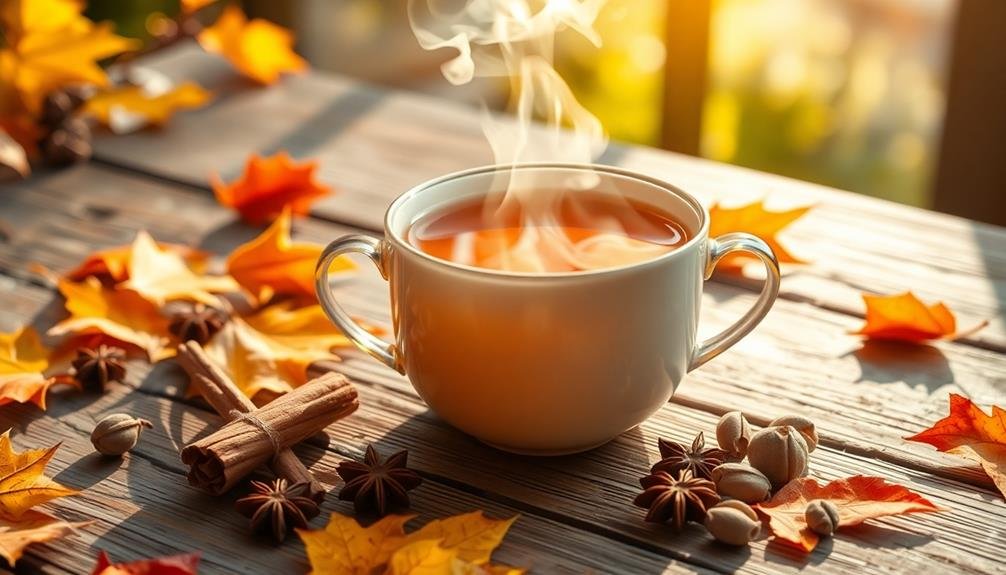
When selecting your base tea for a fall spice blend, consider robust options that can stand up to strong flavors. Black teas like Assam, Ceylon, or English Breakfast provide a bold foundation that pairs well with autumn spices. These teas offer a full-bodied taste and rich color, complementing the warmth of cinnamon, cloves, and nutmeg.
For a lighter option, try using Darjeeling or Keemun black teas. They'll still hold their own against spices but offer a more nuanced flavor profile.
If you prefer caffeine-free alternatives, rooibos makes an excellent base. Its naturally sweet, nutty taste enhances fall spices beautifully.
Don't overlook green teas, especially for milder blends. Gunpowder or Chun Mee green teas can provide a smoky undertone that works well with autumn flavors.
For a unique twist, consider using oolong as your base. Its complex character can add depth to your spiced tea creation.
Select Signature Fall Spices
Fall's signature spices are the heart of any autumn-inspired tea blend. To create your perfect fall spice tea, you'll need to carefully select and balance these flavors.
Start with cinnamon, the quintessential autumn spice. It adds warmth and sweetness to your brew. Next, consider adding ginger for a spicy kick and digestive benefits. Nutmeg offers a rich, nutty aroma that complements most teas beautifully.
Don't forget about cloves, which bring a deep, earthy flavor and aroma to your blend. Cardamom can add a unique, slightly sweet and pungent taste. For a twist, try adding star anise for its licorice-like flavor or allspice for its complex, peppery notes.
If you're feeling adventurous, a touch of black pepper can add depth and heat to your blend. Remember to start with small amounts of each spice and adjust to your taste preferences.
You can use whole spices for a more subtle flavor or ground spices for a stronger impact. Experiment with different combinations to find your perfect fall spice tea blend. Don't be afraid to try unconventional additions like vanilla or orange peel for added complexity.
Balance Flavors and Aromas
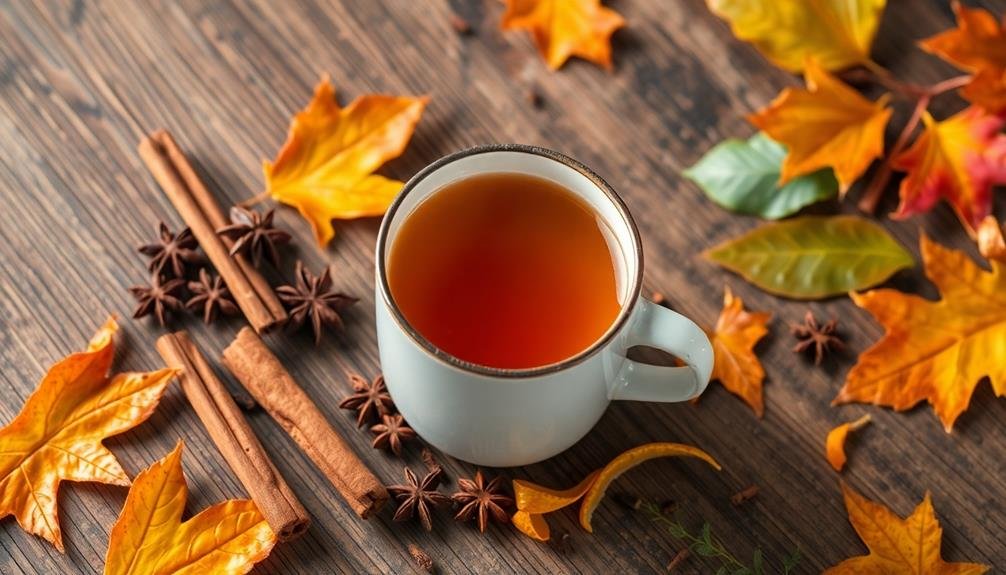
Once you've selected your fall spices, achieving the right balance of flavors and aromas is key to creating a memorable tea blend. Start by considering the strength of each spice and how they interact. Cinnamon and ginger can easily overpower milder flavors, so use them sparingly. Nutmeg and allspice offer subtle warmth, while cloves provide a sharp, intense note.
Experiment with different ratios to find your perfect combination. A good rule of thumb is to use stronger spices in smaller quantities and milder ones more liberally.
Don't forget to account for the base tea's flavor profile. Black teas can stand up to bolder spices, while green or white teas pair well with gentler aromatics.
Consider adding complementary ingredients like dried apple pieces, orange peel, or vanilla bean to enhance the overall flavor profile. These can help bridge gaps between spices and create a more cohesive blend.
Remember that aroma plays a significant role in the tea experience, so pay attention to how the scents mingle as you're blending. Finally, taste-test your creation and adjust as needed, keeping in mind that flavors will develop further during steeping.
Experiment With Sweeteners
To truly elevate your fall spice tea, don't shy away from experimenting with different sweeteners. Each option can bring a unique flavor profile to complement your spice blend. Try classic choices like honey or brown sugar, or explore less conventional options such as maple syrup or agave nectar.
Consider how each sweetener interacts with your tea's spices. For example, honey pairs well with cinnamon and ginger, while maple syrup complements nutmeg and cloves. Adjust the amount to suit your taste, starting with a small quantity and gradually increasing until you reach your desired sweetness level.
Here's a quick guide to some popular sweeteners and their characteristics:
| Sweetener | Flavor Profile | Best Paired With |
|---|---|---|
| Honey | Floral, rich | Cinnamon, ginger |
| Maple Syrup | Caramel-like | Nutmeg, cloves |
| Brown Sugar | Molasses-y | Cardamom, allspice |
Don't forget about sugar alternatives like stevia or monk fruit extract if you're watching your calorie intake. These natural sweeteners can provide sweetness without the added calories. Remember, the goal is to enhance, not overpower, the delicate balance of spices in your fall tea.
Perfect Your Brewing Method

While sweeteners can enhance your fall spice tea, the brewing method plays an equally important role in creating the perfect cup.
Start by selecting high-quality loose-leaf tea or tea bags, ensuring they're fresh for peak flavor. Use filtered water to avoid any off-tastes from impurities.
Heat your water to the appropriate temperature for your chosen tea base. Black teas typically require boiling water, while green or white teas need slightly cooler temperatures.
Steep your tea for the recommended time, usually 3-5 minutes for black teas and 2-3 minutes for green teas.
To infuse fall spices, you can add them directly to the brewing tea or create a separate spice sachet. Cinnamon sticks, whole cloves, star anise, and cardamom pods work well.
Experiment with ratios to find your ideal blend.
For a stronger spice flavor, try the "double brew" method. Brew your tea as usual, then reheat it with your chosen spices for an additional 3-5 minutes.
Strain before serving to remove any loose spices.
Frequently Asked Questions
Can Fall Spice Tea Be Served Cold or Iced?
Yes, you can definitely serve fall spice tea cold or iced! It's a invigorating twist on the classic warm version. Simply brew your tea as usual, let it cool, and pour over ice. You'll love this chilled autumn treat.
How Long Can Homemade Fall Spice Tea Blends Be Stored?
You can store your homemade fall spice tea blends for up to six months in an airtight container. Keep them in a cool, dark place to preserve their flavor and aroma. Don't forget to label them with the date you made them.
Are There Caffeine-Free Alternatives for Fall Spice Tea?
You'll find plenty of caffeine-free fall spice tea options. Try herbal blends with ingredients like rooibos, honeybush, or chamomile. You can also make your own by mixing spices like cinnamon, ginger, and nutmeg with caffeine-free tea bases.
Can Fall Spice Tea Be Used in Baking or Cooking Recipes?
Yes, you can use fall spice tea in baking and cooking! Try infusing it into cakes, cookies, or breads. You'll add warm, cozy flavors to your dishes. It's great for marinades, sauces, and even cocktails too.
Are There Any Potential Health Benefits Associated With Fall Spice Teas?
You'll enjoy potential health benefits from fall spice teas. They're often packed with antioxidants, can boost your immune system, aid digestion, and may reduce inflammation. Some spices might even help regulate blood sugar and improve heart health.
In Summary
You've now got the tools to craft your ideal fall spice tea. Don't be afraid to experiment with different combinations of teas, spices, and sweeteners. Trust your taste buds and adjust as needed. Remember, the perfect brewing method can make all the difference. As you sip your creation, you'll enjoy the warmth and comfort of autumn in a cup. Keep refining your recipe, and you'll soon have a signature fall tea to savor all season long.


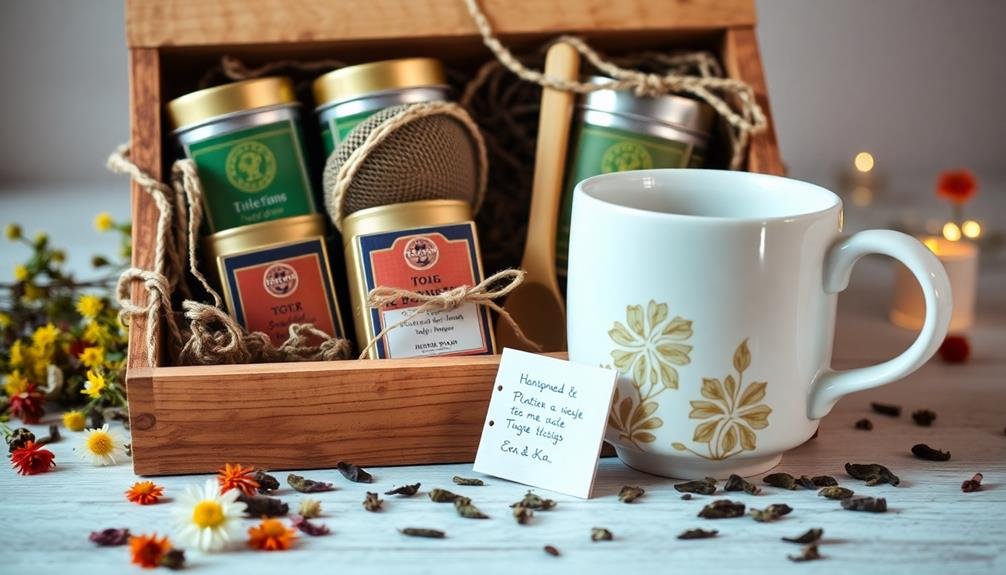
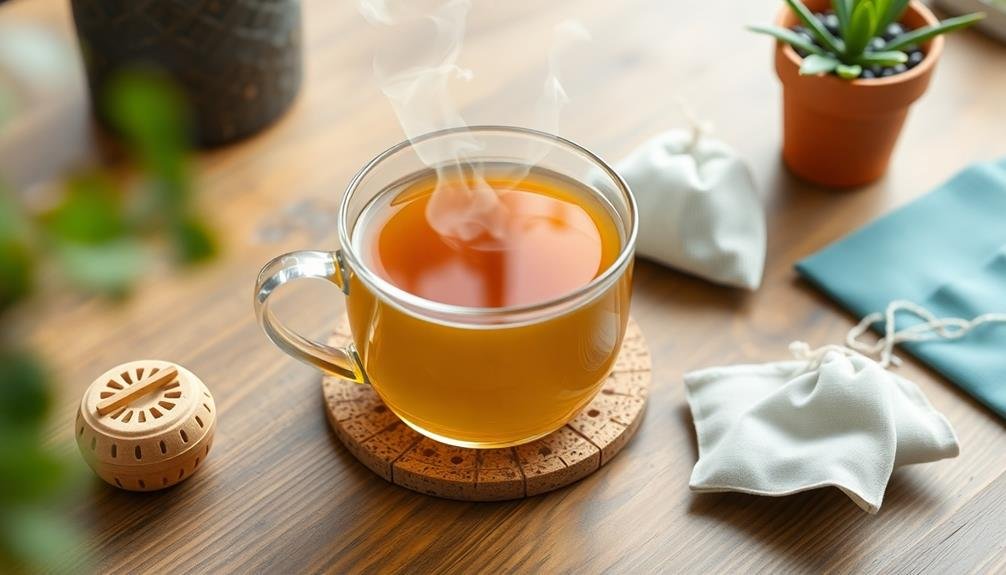
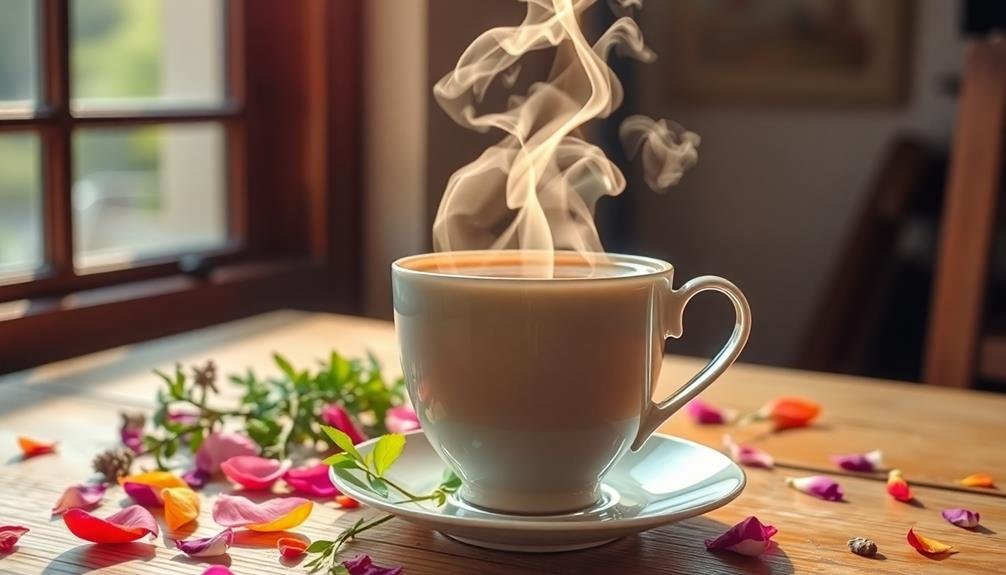
Leave a Reply